Artist Journal - when light turns to dust - from a series of discarded negatives - 2005 - © Lloyd Godman - click here for free PDF version - 2.11mb
When
Light Turns to Dust - Artist Journal - Lloyd Godman
I lived in the same house at Brighton, Dunedin, New Zealand for nearly 30 years, but it was only during the
summer of 2002-3, that I discovered a series of negatives had been left
lying on the ground in the cellar by a previous owner. My shock discovery
led to an instant eagerness to bring these into the light and view the
mysterious images, discover something of the previous owner and the people
and places that might be in the forgotten images. I figured that these
abandoned negatives should hold the residue of a previous light encounter
embedded onto the surface, should retain a history of light locked away
in silver, that they would reveal moments from a Bartesian death to the
discoverer.
But my expectations
were shattered; the ravages of time had taken its toll on the delicate
images. Virtually all the silver embedded gelatin had been eaten away,
leaving only the faintest of traces, and then only as obscure, unrecognizable
marks. The memory of the people, events and places that were once held
on the negatives had effectively been eroded through time until all photographic
representation had vanished. Yet, despite this complete dissolving of
a past memory, a stunning new image emerged from the transparency of each
negative. The developed silver had been reduced to no more than dust,
but a dust with its own codes of intricate, abstract patterns. I was holding
a new artifact, the evidence of light transcending, disintegrating but
being reborn, phoenix like as dust patterns. The original reference to
light had been replaced with decades of dust, dirt and clay fragments.
Ironically dust is an enemy that can frustrate the photographer, and yet
these images were now made almost entirely from generations of dust build
up. Too busy at the time on a building project to rescue or discard them,
I simply left the negatives where they were (like one might leave the
corpse of an animal discovered in the wilderness).
Later in 2003 I was invited by Peter Fitzpatrick to submit work for an exhibition at the ACU Gallery in Canberra based on Zero –Light. Scientists, (led by Dr Lane Vaestergaard Hau of Harvard University and the Rowland Institute for Science in Cambridge, Mass., and another team lead by Dr Lukin of the Harvard-Smithsonian Centre for Astrophysics, also in Cambridge, had discovered that light could not only be slowed down, but stopped, and it was this discovery that inspired Fitzpatrick to Curate the show.
Light has been central to my work for sometime, and late in 2002 I had completed a work at the Blue Oyster Gallery in Dunedin, New Zealand, titled “@ the Speed of Light”, and from this work Peter was interested in my interpretation of “Zero Light”.
From the
invitation, the chance discovery of the discarded negatives surfaced once
more, and with the connection that there was no reference to light left
on the negatives, I decided to make enlargements directly from the "dust"
negatives for the exhibition. At this time the negatives gained a new
importance: they were retrieved from their dark damp home and placed into
archival storage. While there was coincidence in someone leaving a series
of negatives in the cellar of a house that a photographer would later
own, and that they should lie undiscovered for years until a point when
there was a conceptual collision, there was also coincidence that the
transformation of the photographic to the photogramic reflected a similar
change in my photographic practice. Equally strange was that I had slept
over this spot for about 18 years and that during the year of this discovery
I was also invited to contribute to a mailart exhibition titled "The dirt
you sleep on" where artists sent soil samples to an exhibition at Santa
Fe in the USA.
“When Light Turns to Dust” is a project based on enlargements from these forgotten photographic artifacts, where the silver image, the memory of light, was exchanged with layers of dust, grime and dirt. Where the alchemy of decay embedded different abstract mark over a period of years.
Lloyd Godman
2003
It was interesting how the discovery of these negatives coincided with the break up of my marriage and eventual move from the house to my new home at the Baldessin press in Australia.
The site of discovery, where
the negatives lay on the ground for approximately 30 years.
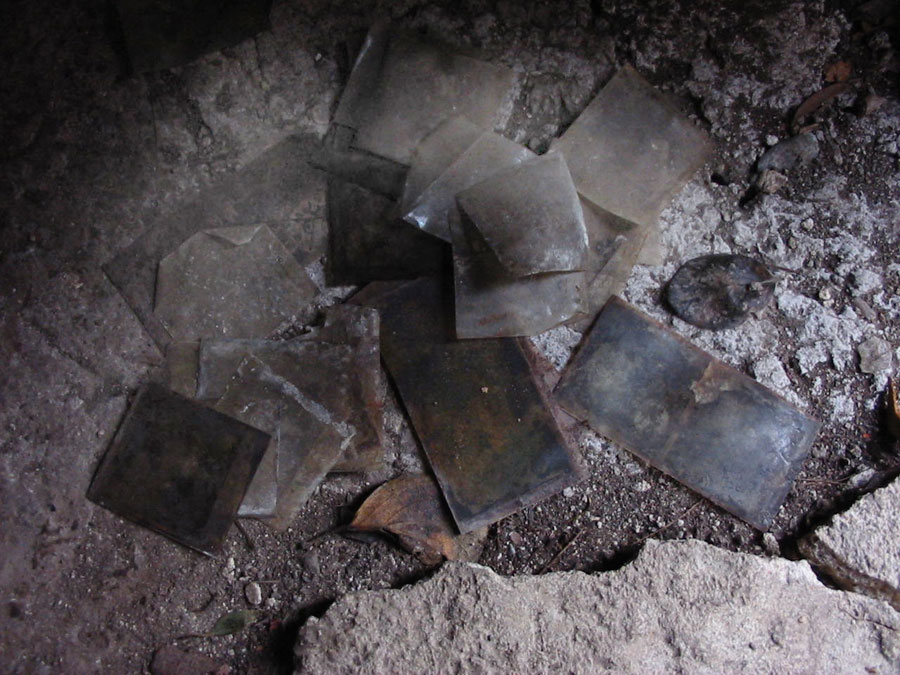 
Site
of Discovery during retrieval, under a mixture of tungsten light and daylight
entering through the door way
Once retrieved, the negatives were treated as artefacts that might have been painstakingly unearthed from an ancient archaeological site. Each negative was catalogued with a number and archived as any precious artefact or photographic negative might be in a similar manner that I would treat any negative I had shot with a camera.
Once removed from the site, the dust on the surface of the negatives became dry and tended to flake off the support base in the process of arranging the negatives for cataloguing and making the photographic enlargements. The dust was stabilized to some extent with an art fixative spray normally used to fix charcoal and pastel drawings.
A magnified examination of the negatives on a light table revealed the reference to the original photographic representation had been totally replaced with a wonderfully tonally rich transparency of dust and grime that had the potential to enlarge through the normal photographic process.
The abandoned negatives had metamorphosed into a new image without realistic representation that symbolized the shift in my art practice from the traditional photograph to the photogram.
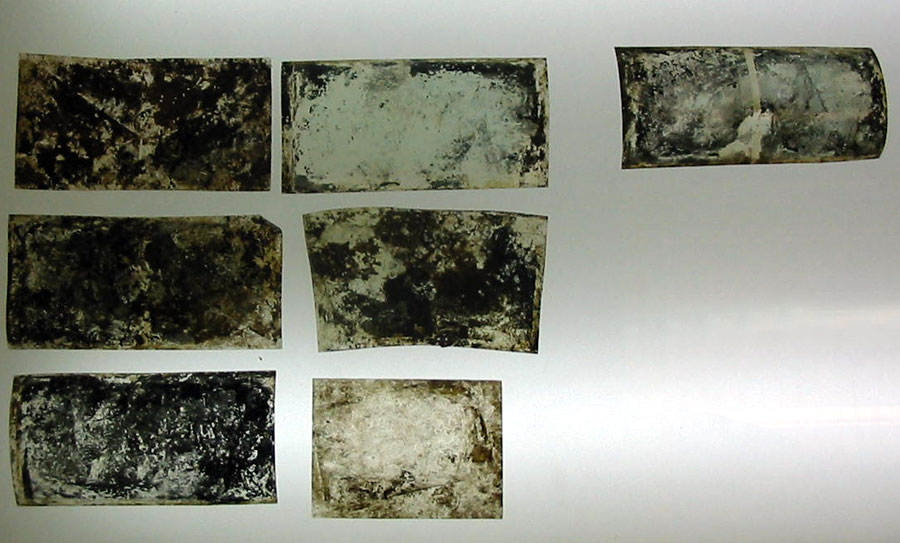
The retrieved Artifacts
laid on a light table for assessment and cataloguing.
 
Detail of Artifacts
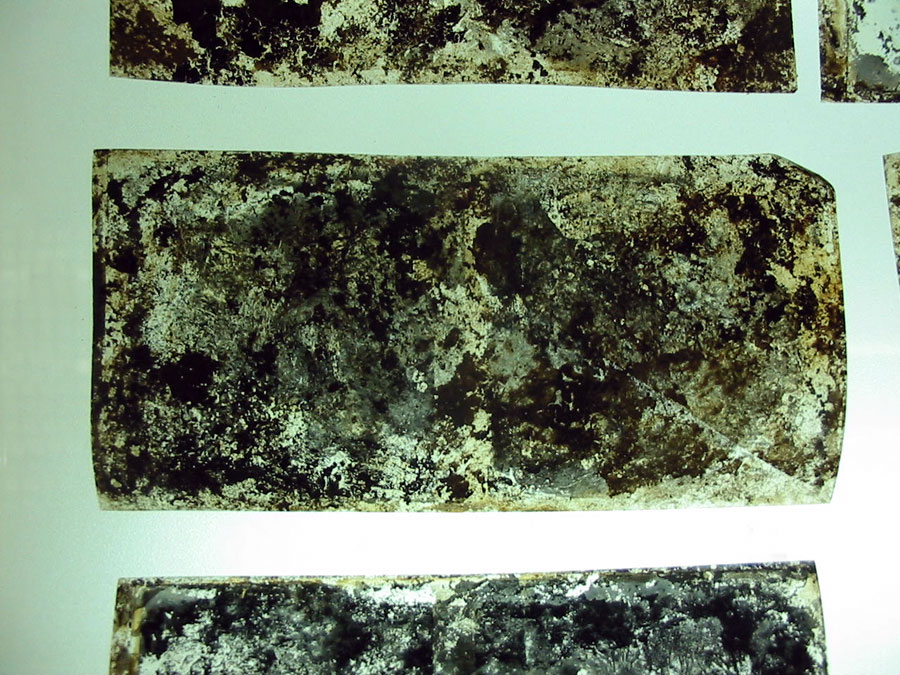 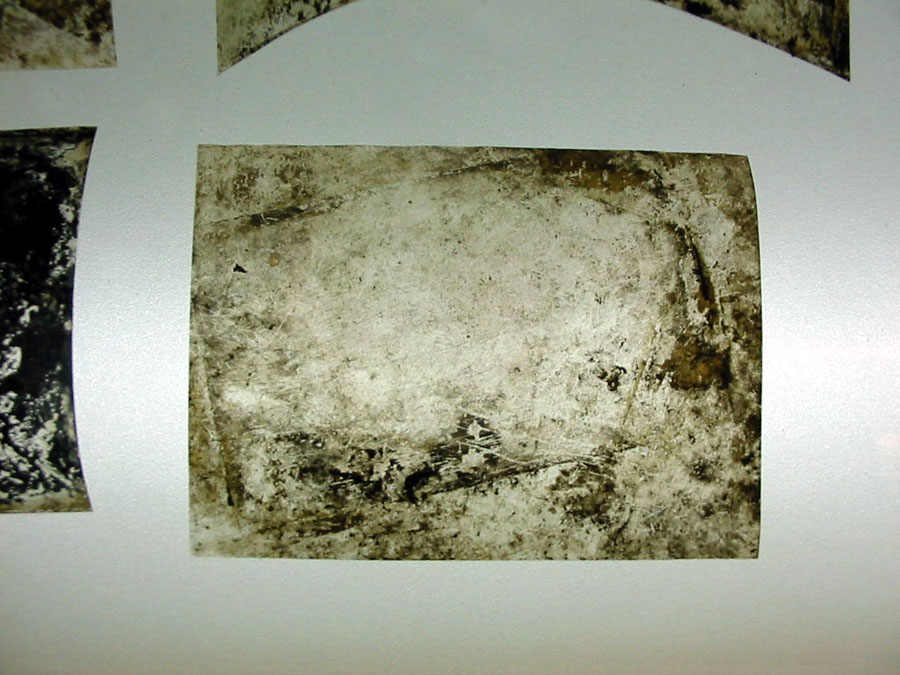
Artifact #1
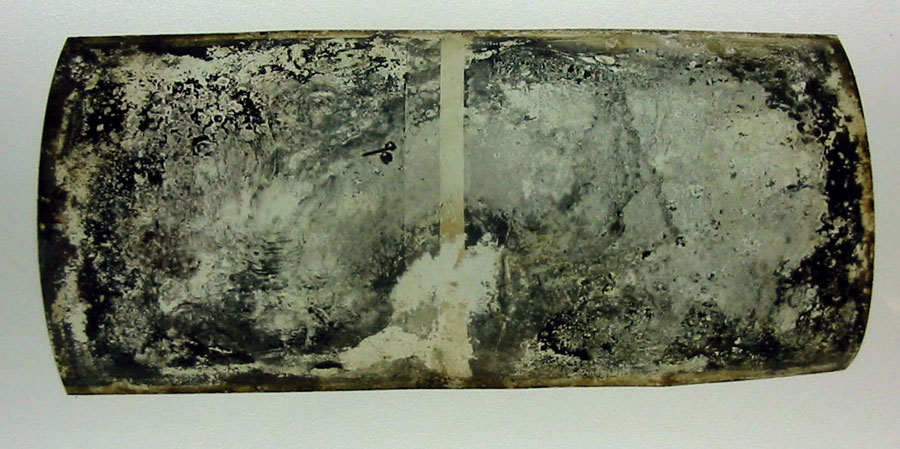
Artifact#2
|